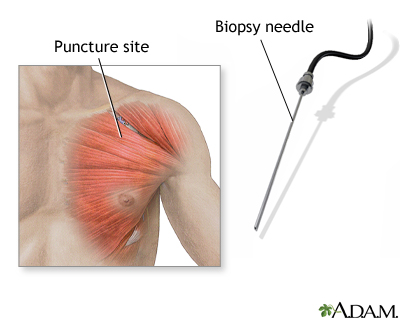Health Library
Muscle biopsy
Biopsy - muscle
A muscle biopsy is the removal of a small piece of muscle tissue for examination.
Images

I Would Like to Learn About:
How the Test is Performed
This procedure is usually done while you are awake. Your health care provider will apply a numbing medicine (local anesthesia) to the biopsy area.
There are two types of muscle biopsy:
- A needle biopsy involves inserting a needle into the muscle. When the needle is removed, a small piece of tissue remains in the needle. More than one needle stick may be needed to get a large enough sample.
- An open biopsy involves making a small cut in the skin and into the muscle. The muscle tissue is then removed.
After either type of biopsy, the tissue is sent to a lab for examination.
How to Prepare for the Test
No special preparation is usually needed. If you will have anesthesia, follow instructions on not eating or drinking anything before the test.
How the Test will Feel
During the biopsy, there is usually little or no discomfort. You may feel some pressure or tugging.
The anesthetic may burn or sting when injected (before the area becomes numb). After the anesthetic wears off, the area may be sore for about a week.
Why the Test is Performed
A muscle biopsy is done to find out why you have muscle weakness or your muscle enzyme lab tests are elevated and your provider suspects you have a muscle disease.
A muscle biopsy may be done to help identify or detect:
- Inflammatory diseases of muscle (such as polymyositis or dermatomyositis)
- Diseases of the connective tissue and blood vessels (such as polyarteritis nodosa)
- Infections that affect the muscles (such as trichinosis or toxoplasmosis)
- Inherited muscle disorders such as muscular dystrophy or congenital myopathy
- Metabolic defects of the muscle
- Effects of medicines, toxins, or electrolyte disorders
A muscle biopsy may also be done to tell the difference between nerve and muscle disorders.
A muscle that has recently been injured, such as by an electromyography (EMG) needle, or is affected by a pre-existing condition, such as nerve compression, should not be selected for a biopsy.
An MRI may be done in advance to show the best site for the biopsy.
Normal Results
A normal result means the muscle is normal.
What Abnormal Results Mean
A muscle biopsy can help diagnose the following conditions:
- Loss of muscle mass (atrophy)
- Muscle disease that involves inflammation and a skin rash (dermatomyositis)
- Various muscular dystrophies (Duchenne muscular dystrophy and other conditions)
- Destruction of the muscle (myopathic changes)
- Tissue death of the muscle (necrosis)
- Disorders that involve inflammation of the blood vessels and affect muscles (necrotizing vasculitis)
- Traumatic muscle damage
- Paralyzed muscles
- Inflammatory muscle disease causing muscle weakness, swelling tenderness, and tissue damage (dermatomyositis or polymyositis)
- Nerve problems that affect the muscles
There are additional conditions under which the test may be performed.
Risks
The risks of this test are small, but may include:
- Bleeding
- Bruising
- Damage to the muscle tissue or other tissues in the area (very rare)
- Infection (a slight risk any time the skin is broken)
Related Information
Muscular dystrophyPolyarteritis nodosa
Trichinosis
Toxoplasmosis
Muscle atrophy
Necrosis
Necrotizing vasculitis
Muscle disorder
Antibody
Duchenne muscular dystrophy
Polymyositis - adult
Dermatomyositis
Becker muscular dystrophy
Charcot-Marie-Tooth disease
Common peroneal nerve dysfunction
Eosinophilic fasciitis
Facioscapulohumeral muscular dystrophy
Hypokalemic periodic paralysis
Polymyalgia rheumatica
Cardiac amyloidosis
Thyrotoxic periodic paralysis
References
Selcen D. Muscle diseases. In: Goldman L, Cooney KA, eds. Goldman-Cecil Medicine. 27th ed. Philadelphia, PA: Elsevier; 2024:chap 389.
Shepich JR. Muscle biopsy. In: Fowler GC, ed. Pfenninger and Fowler's Procedures for Primary Care. 4th ed. Philadelphia, PA: Elsevier; 2020:chap 188.
Warner WC, Sawyer JR. Neuromuscular disorders. In: Azar FM, Beaty JH, eds. Campbell's Operative Orthopaedics. 14th ed. Philadelphia, PA: Elsevier; 2021:chap 35.
BACK TO TOPReview Date: 7/22/2024
Reviewed By: Neil J. Gonter, MD, Assistant Professor of Medicine, Columbia University, NY and private practice specializing in Rheumatology at Rheumatology Associates of North Jersey, Teaneck, NJ. Review provided by VeriMed Healthcare Network. Also reviewed by David C. Dugdale, MD, Medical Director, Brenda Conaway, Editorial Director, and the A.D.A.M. Editorial team.
 | A.D.A.M., Inc. is accredited by URAC, for Health Content Provider (www.urac.org). URAC's accreditation program is an independent audit to verify that A.D.A.M. follows rigorous standards of quality and accountability. A.D.A.M. is among the first to achieve this important distinction for online health information and services. Learn more about A.D.A.M.'s editorial policy, editorial process and privacy policy. A.D.A.M. is also a founding member of Hi-Ethics. This site complies with the HONcode standard for trustworthy health information: verify here. |
The information provided herein should not be used during any medical emergency or for the diagnosis or treatment of any medical condition. A licensed medical professional should be consulted for diagnosis and treatment of any and all medical conditions. Links to other sites are provided for information only -- they do not constitute endorsements of those other sites. No warranty of any kind, either expressed or implied, is made as to the accuracy, reliability, timeliness, or correctness of any translations made by a third-party service of the information provided herein into any other language. © 1997- 2025 A.D.A.M., a business unit of Ebix, Inc. Any duplication or distribution of the information contained herein is strictly prohibited.
